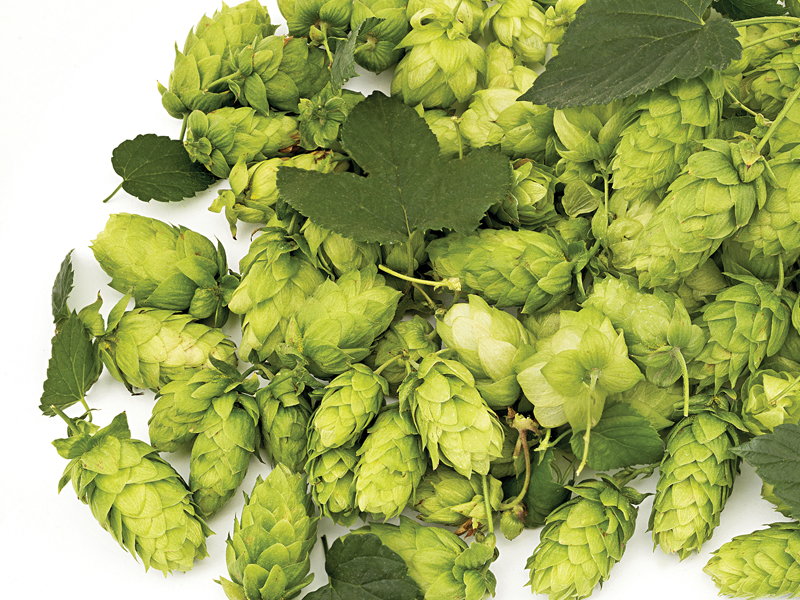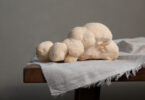It is believed that pale ales, specifically the India pale ale (IPA), was born from the desire to send a beer long distances to British troops colonizing in India. Due to the spoilage of darker beers en route, a paler, more heavily hopped beer was crafted; the increase in hops was useful as a natural preservative for the often 90-plus day sea voyage.
Harvested from the female hop plant, hop flowers, or hop cones, contain essential oils, alpha acid and beta acid resin. These attributes impart the aromas and flavors we’ve come to appreciate and expect in hop-forward beers.
When you’re investigating your IPA, and you notice citrus, floral or piney aromas, you’re experiencing the effects of the hops essential oils on the brew. The alpha acids lend a bitterness to the beer, often used to offset any malty sweetness.
And as with the British IPA created for lengthy travel, the beta acid resin contributes an antibiotic and preservative effect.
Hops are grown much like grapes, but instead of a grape vine it’s a hop bine. Akin to grapes, the place where the plant is grown will impart specific characteristics to the hop flower, giving rise to regionally specific hop varieties. You may often see them growing on what look like tower wire trellis, stretching up higher than 7 feet. Areas of Germany, the Czech Republic, England and the U.S. Pacific Northwest are
all known for their desirable hop varieties and suitable growing climates.
Beer contains four cornerstone ingredients: water, malt, hops and yeast. That said, there are a variety of other ingredients that play important roles and main ingredient variables that dictate the entirety of a beer, along with the way in which the process of making the beer is executed. The big, bold flavors you enjoy so much in an award-winning beer were created through precision and careful brewing, not often by chance. Brewed with roughly twice the amount of hops, IPAs are often characterized by their citrus zest, crispness and bitterness. Originating in the 1830s, IPAs time in the hop-light was limited.
By the 1880s it had been replaced in the public eye by convenient lager-style beers. It wasn’t until American craft brewers reintroduced the style in the late 1990s, almost 100 years after the style had nearly disappeared, that it rose in popularity again. The IPA brew has since skyrocketed and stands as one of the most favored beer styles in the United States.
Don’t be fooled by the term “pale ale,” many of these beers will range from a soft golden color to a deep amber. There are five distinct styles of pale ales: the English pale ale and IPA, the American pale ale and IPA and the American double/imperial IPA. Outside of these five, other specialty creations exist, such as the introduction of a rye malt, adding an overall spiciness to the beer, which strongly complements the hops kick and notable flavors.
Hop Terms
IBU
An abbreviation for international bittering units, this scale measures from 1 to 100, the expressed bitterness of a beer with 1 being the least bitter and 100 being the most. Alpha acids in the hop flower impart a bitterness to beer during the boiling process. But don’t be fooled, stouts and barley wines, for example, can be rated higher on the IBU scale but have a strong malt presence that over shadows the hoppy bitters.
Hop Bine
These bines can be found growing vertically, using stiff hairs or bristles to attach to their supports. When the harvest is over, the tall growth dies back and the following season the root system sends up new shoots to start again.
Dry Hopping
This method of brewing entails brewers putting hops into the beer after the boil and fermentation phases. It’s done with the intention of avoiding essential oil evaporation from the hops during the boil, so more of the hop aroma and flavor is maintained.
Wet Hopping
A slightly more difficult venture, wet hopping is the steeping of hops that are freshly harvested. It captures pure and undiluted hop flavor and aromas. The challenge comes from harvesting the hops at the same time the brewing is happening—unless dried, hop flowers spoil quickly.
Session
Any style of beer with an ABV of 5.1% or less and exhibiting well-balanced malt and hop characteristics. Intended for consuming multiple beers without becoming intoxicated in a single session.
Brew Review
PALATE WRECKER
IMPERIAL INDIA PALE ALE
GREEN FLASH BREWING COMPANY
IBU 100+ ABV 9.5%
AVAILABILITY: JANUARY – APRIL
Smells citrusy and herbal with a similar palate experience, but be ready because the zesty notes will go aggressively hop forward in a hurry; delightfully hoppy and crispy with a medium body.
BLACK RYE
DRY HOPPED DARK ALE WITH RYE
FOUNDERS BREWING COMPANY
IBU 78+ ABV 7.5%
AVAILABILITY: JANUARY – MARCH
Slightly darker than your usual pale beer, this brew has the aromas of rye malt, chocolate and hops. Get ready for a palate party as flavors of espresso and chocolate mingle with the hops and rye malt kick.
GO TO IPA
SESSION IPA
STONE BREWING COMPANY
IBU 65 ABV 4.5%
AVAILABILITY: ALL YEAR
Enticing citrus and tropical fruit nose with similar dominating flavors on the palate.
It has a mid-weight hop kick with a light and crispy body.
BITTER VALENTINE
DOUBLE IPA
ALEWERKS BREWING COMPANY
IBU 70 ABV 9%
AVAILABILITY FEBRUARY – LIMITED RELEASE
Loads of tropical fruit smells from mango and kiwi make up this beer. It’s flavors don’t miss a beat, and after the tropical stuff finishes, you’re met with a hoppy, somewhat sweet takeover. It’s a snappy beer with moderate carbonation and a medium body.


